The Ocicat is a famous shorthaired cat breed that closely resembles the wild mammals of the ocelot in color. An artificially bred breed has recently become popular with domestic and foreign breeders.
Ocicats are very sociable cats, their habits more like canines than felines. They are easy to train, allow you to behave on a leash, respond to a name, and perform other “doggy” tricks.
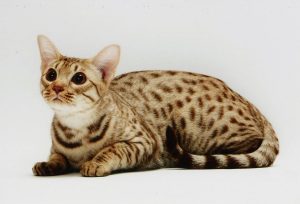
The original species of the Ocicat are very similar to their wild relatives, including the fishing cat from Egypt, as well as the swamp lynx and small South American leopard ocelots. The history of the breed is connected with Virginia Dale and the American state of Michigan, where the Siamese cats bred by her were crossed with Abyssino-Siamese mestizos.
As a result of breeding work, we managed to get a kitten with an interesting creamy coat with unusual golden spots. The kitten was given the name “Tonga”, and it is he who is considered the first representative of the Ocicats. Further improvement of the characteristics of the breed through experimental crosses made it possible to obtain and register in 1987 the world-famous breed of cats, the Ocicat, recognized by the ACF, FIFE, WCF, CFA, ACFA, and TICA.
A little less than thirty years ago, TICA developed the first standard, which subsequently underwent many changes. It is currently recommended to focus on the following breed characteristics:
- the rounded, wedge-shaped head has a gentle curve from the muzzle to the flaps and a slight gradual transition from the nose to the forehead. The shape of the muzzle is closer to the square in front, rather elongated in profile, with a strong chin and a well-developed lower jaw. An obligatory characteristic of the breed is the presence of the correct bite, and the standards take into account the presence of a double chin or dewlap in adult males. The cervical region is rather long and graceful.
- the ears are rather large, triangular in shape, with a landing that continues the outer upper corners of the muzzle. The presence of tassels on the tips of the ears of the “lynx” is allowed, giving the animal a certain wild charm. The eyes are large, oblique, with a characteristic almond shape. Any eye color is allowed by the standards, even if it does not match the color, with the exception of blue. An additional advantage is the rich color of the iris;
- the long body has a strong and rather heavy bone structure. The ribcage is wide, with rounded ribs. A distinctive feature is a muscular and athletic body with a raised backline to the tail. Due to the heavy bones, the adult Ocicat is heavier in weight than other purebred cats. The average weight of a female ranges from 3.5 to 5.0 kg and the weight of an adult male reaches 6.5-7.0 kg. A high show result is influenced not by body weight, but by indicators of proportionality and physique, which should be athletic;
- paws proportionately built, of medium length, well developed, and well-expressed musculature. The front feet have five toes, and the hind feet have four.
Interesting! The long and relatively thin tail has a taper at the end. According to color standards, the tip of the tail has a characteristic dark coloration.
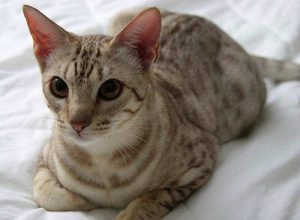
Ocicats are characterized by a short and rather thick coat, and in accordance with the breed characteristics, they should be silky, smooth to the touch, with a noticeable shimmer. A complete absence of fluff is required. An obligatory breed characteristic of the Ocicat is ticking, which consists of a clear contrasting pattern on the coat.
Ticking is the color of the coat where each hair is dyed in several stripes of different colors (usually dark and light).
The main types of Ocicat color:
- tawny or “Tawny” coloration, represented by warm brown or light bronze coat with dark brown or black spots;
- chocolate coloring or “Chocolate”, represented by light brown color, agouti or ivory with the presence of chocolate spots;
- brown coloration or “Cinnamon”, represented by light agouti or ivory with tawny spots;
- blue coloration or “Blue”, represented by a faint bluish background and saturated blue spots;
- lilac coloration or “Lavender”, represented by a pale yellow or matte beige color with soft
- lavender spots;
- tawny or “Fawn”, represented by basic agouti or ivory with yellow-brown, subtle spots.
In addition to the six main color options, there are combinations in silver, which are combined into six types and are represented by silver-white, gray, or silver-black coloration with spots of chocolate, reddish-brown, dark brown, or black, deep blue, or lavender.
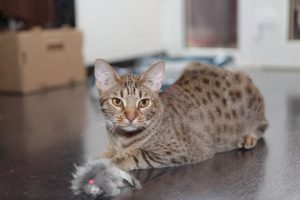
The category “Any Other Variety” includes the following types of Ocicat color:
- ticked or unstained on the general background;
- solid color or “Solid” with spots in the form of light shadows on the general background;
- classic Aztec color or “Classic tabb” with marbled color.
Such standards are adopted by felinological European associations and are not taken into account in world championships.
Ocicats with a marbled tabby-colored coat belongs to a separate breed “Jungala”, which takes part in separate championships, and has the following breed characteristics:
- spotted coloration over the entire surface of the body;
- on the back and sides, the spots are arranged in a kind of imperfect rows;
- there are spots on the abdomen that resemble fingerprints;
- paws have basic coloration and incomplete framing
ring “bracelets”; - on the trail there are dark “bracelets”, the number of which becomes more frequent towards the end part, painted in a dark color;
- on the neck there is a semi-collar pattern in the form of a torn necklace;
- on the frontal part, there is a well-defined scarab pattern in the form of the letter “M”.
Ocicat “Jungal” eyes have a very characteristic and consistent framing of dark or light coloration.
Non-show Ocicats may have one or more defects, which are represented by the following features:
- white spots in areas that are not defined by breed standards;
- the presence of visual or hidden tail defects;
- blue eye color;
- long or fluffy coat;
- the wrong number of fingers on the limbs.
Also, animals with non-standard or unauthorized breed characteristics of color are not allowed to the championships.
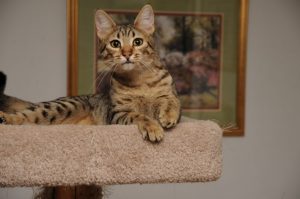
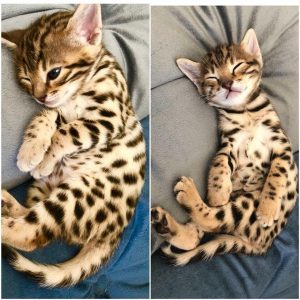
The Ocicat is an active breed, very sociable and inquisitive. Cats of this breed are very attached to their owners, loyal to the family, and also friendly towards children and other pets, without trying to dominate the neighboring cat breeds.
Ocicats are very social creatures. They will never sit in the back room under the sofa if guests come to you.
Among other things, the breed is distinguished by high intellectual abilities. Such an animal quickly remembers its name and some commands of the owner, therefore it is easy to train and is characterized by the ability to self-study. Ocicats never show unmotivated aggression, and attract attention to themselves with a fairly loud, drawn-out meow.
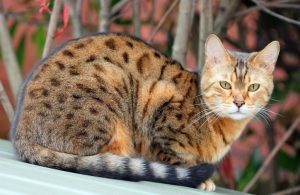
According to breeders and veterinarians, Ocicats are a fairly hardy and healthy breed that does not require complex and special care. The animal’s coat is smooth, fluffy, and short, therefore, care measures include periodic brushing with a special comb for cats. During the shedding period, brushing is carried out daily or every other day, and to give shine, after combing, the wool is wiped with suede.
A feature of the breed is its tendency to damage the oral cavity with periodontal disease, therefore, in order to maintain the health of a pet, it is very important to regularly brush its teeth with a special toothpaste. Every year it is necessary to show the pet to the veterinarian in order to assess the condition of the teeth.
It is recommended to use a bleaching shampoo to clean the silvery Ocicat. Show animals should be washed with special tint detergents. Once a week, you need to rinse the animal’s eyes with a cotton swab soaked in clean water, and also clean the outer ears with cotton swabs.
In warm seasons and dry weather, you can walk your pet on a harness, remembering to use special protective equipment against blood-sucking ectoparasites.
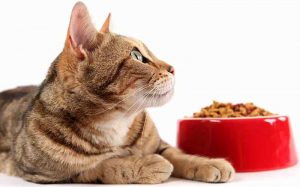
The preparation of the Ocicat diet should be taken very carefully, and the following recommendations of experienced breeders and specialists should be adhered to:
- use premium dry food designed to feed the Siamese or Oriental breed;
- with natural feeding, give preference to meat in the form of boiled beef or chicken and dairy products;
- weekly supplement the diet with boiled sea fish, as well as vegetables and eggs.
It is strictly forbidden to use products such as river fish, pork, milk, as well as spicy, sweet, and fried foods for feeding your pet. A good result is obtained by the use of powder bio-additives and a special paste based on vegetable oil. Natural products are fed freshly prepared, warm.

